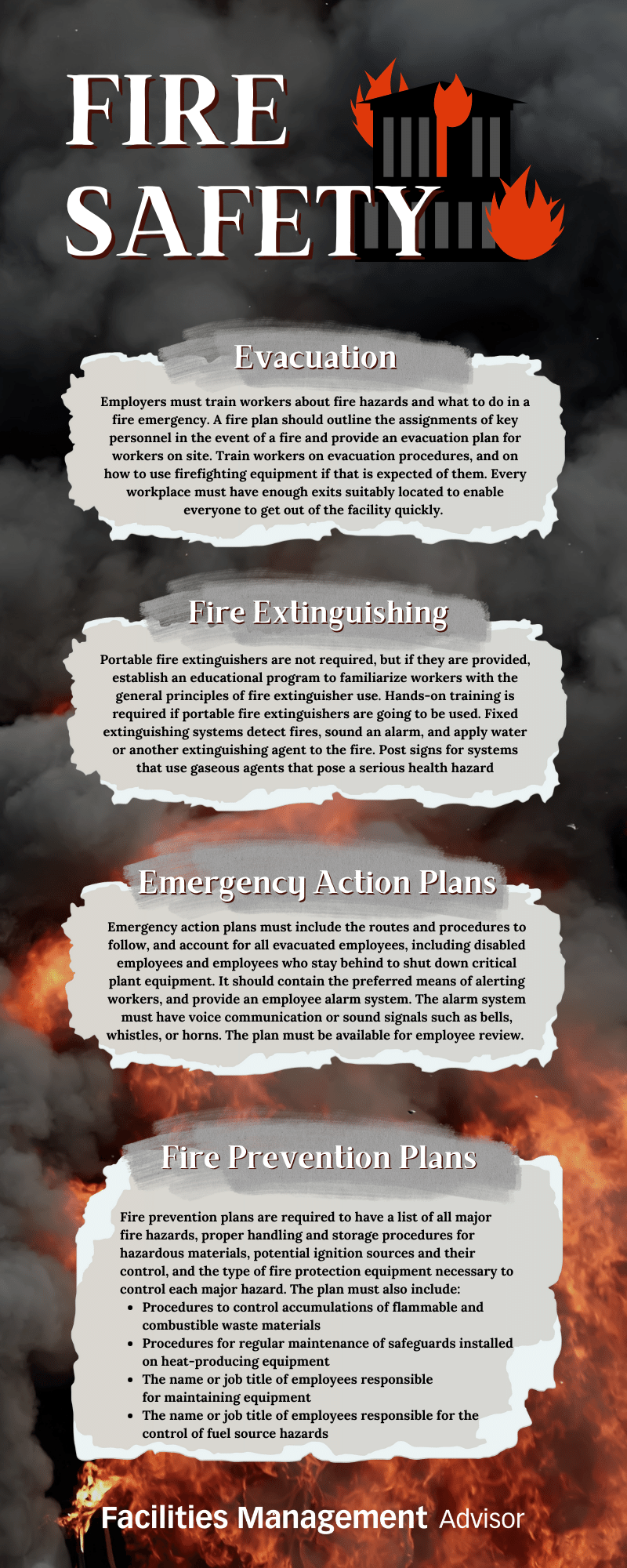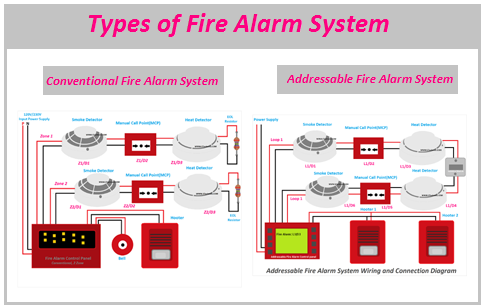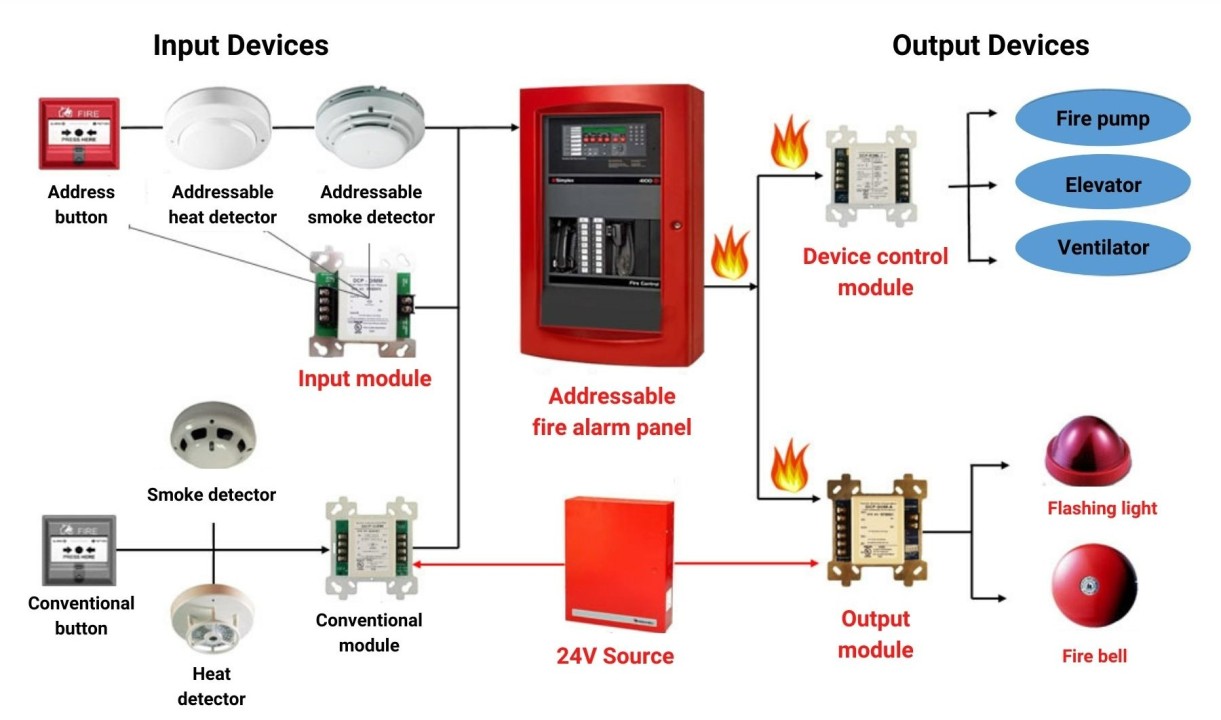Conventional fire detection systems utilize physical hardware to detect fires. They signal alarms when detecting smoke or heat.
Initiating with simplicity, conventional fire detection systems are the bedrock of safety in both residential and commercial spaces. These systems comprise sensors and alarms that react to the presence of fire-related dangers such as smoke, heat, or flames. They work on the principle of zone defense, where each area monitored is a designated zone that gets wired back to a central control panel.
This ensures immediate detection of potential hazards, enabling quick response to prevent loss and damage. They’re relatively straightforward to install and cost-effective, making them a popular choice for small to medium-sized establishments. Despite the emergence of more advanced systems, conventional fire detection remains a trusted ally in fire safety, providing fundamental protection and peace of mind.
Introduction To Fire Safety
Ensuring safety from fires in buildings is a critical aspect of modern living. The threat of fire poses a significant risk to both life and property. Effective fire safety measures can save lives, safeguard assets, and provide peace of mind for occupants. This post explores the importance of conventional fire detection systems in modern buildings, a cornerstone of a holistic fire safety strategy.
Fire Hazards In Modern Buildings
Modern constructions come with unique fire hazards. This includes:
- Complex electrical systems
- High-density occupation
- Flammable materials
Understanding these hazards is key to designing effective fire safety protocols.
Role Of Detection Systems In Fire Safety
Fire detection systems play a vital role in fire safety. Their primary tasks encompass:
- Detecting fire at the earliest stage
- Alerting occupants promptly
- Facilitating timely evacuation
- Enabling faster response to extinguish fires
Conventional fire detection systems form an integral part of building safety infrastructure, ensuring quick and efficient response during emergencies.
Types Of Fire Detection Systems
When safety is a priority, understanding fire detection systems is crucial. Knowing the types can save lives and property. Let’s explore these systems in detail.
Smoke Detectors
Smoke Detectors
Smoke detectors are a first line of defense against fires. They sense smoke particles in the air. Here are the common types:
- Ionization Detectors: Quick to detect flaming fires.
- Photoelectric Detectors: Best for smoldering fires.
- Dual-Sensor Detectors: Combine both technologies for comprehensive coverage.
Heat Detectors
Heat Detectors
Heat detectors sense a rise in temperature. They activate at set temperature thresholds. They are ideal for areas where smoke detectors may false alarm.
| Type | Activation Method |
|---|---|
| Fixed Temperature | Activates at a pre-defined temperature. |
| Rate-of-Rise | Triggers on rapid temperature increase. |
Flame Detectors
Flame Detectors
Flame detectors are advanced fire detection devices. They recognize specific light wavelengths from flames. Fast and accurate, they suit high-risk environments.
- Ultraviolet (UV) Detectors
- Infrared (IR) Detectors
- UV/IR Detectors
Gas Detectors
Gas Detectors
Gas detectors play a key role in preventing fires. They detect flammable gases before they ignite. Various types are tuned to specific gases:
- Natural Gas Detectors
- Propane Detectors
- Carbon Monoxide Detectors
Key Components And Functionality
Understanding the key components and functionality of a conventional fire detection system is crucial. Each part works together to keep you safe from fire hazards. Let’s dive into its main features.
Sensors And Detectors
Sensors and detectors are the eyes of a fire detection system. They constantly check the environment for signs of smoke or heat. When they sense danger, they trigger the system to act. Here’s what they include:
- Smoke detectors: Spot fire smoke quickly.
- Heat detectors: React to a rise in temperature.
- Manual call points: Let people activate the alarm by hand.
Alarm Signaling Devices
Alarm signaling devices are the voice of the fire detection system. They alert people with loud sounds or flashing lights when a fire occurs. This includes:
- Bells: Create a loud ringing noise.
- Sounders: Emit a high-pitched alarm.
- Flashing lights: Warn those who are hearing-impaired.
Control Panels
The control panel is the brain of the operation. It gets information from sensors and tells alarms to start ringing. It also shows which detector found the fire. This helps firemen find the flame fast.
Power Supply Essentials
A reliable power supply is vital. It must work all the time, even during power cuts. A good system has:
| Main Power | Backup Battery |
|---|---|
| Connects to the building’s electricity | Kicks in if the main power fails |

Credit: facilitiesmanagementadvisor.blr.com
Operation Of Conventional Systems
Understanding how conventional fire detection systems operate is key to ensuring safety. These systems form the backbone of many buildings’ fire protection strategies. Let’s dive into what makes these systems reliable guardians against the threat of fire.
Zoned Protection Strategy
In conventional fire detection systems, the coverage area is divided into zones. Each zone aligns with specific sections of a building. This organization simplifies locating the origin of a fire alarm. When a fire triggers an alarm in a zone, responders can swiftly identify the location and take rapid action.
- Zones are clearly labeled on the control panel.
- Alarm sources are easily pinpointed within a defined zone.
- Systems typically cover a limited number of zones due to wiring.
Alarm Activation Process
When a sensor detects fire conditions such as smoke or excessive heat, an electric circuit within the zone is disrupted. This disruption triggers the alarm. The control panel receives this signal and activates the sounders to warn of danger.
- Sensors monitor environmental changes.
- A disruption in the circuit signals a fire event.
- The control panel responds by sounding the alarm.
Manual Vs. Automatic Operation
Conventional fire systems come with manual and automatic functions. Pull stations provide a manual means to activate alarms. Automatic operation involves sensors and detectors kick-starting the alarm without human intervention.
| Manual Operation | Automatic Operation |
|---|---|
| Pull stations positioned for easy access. | Sensors that detect heat, smoke, or fire automatically. |
Both methods are critical for a robust fire response plan. Manual stations act as a backup to the automatic sensors and ensure that there are no single points of failure in the system.
Installation And Placement
Installing a conventional fire detection system is vital for safety. Proper placement can save lives and property. It’s more than just putting up detectors; it’s about smart positioning. Let’s dive into how to place these systems for the best results.
Strategic Placement For Maximum Efficiency
A well-planned layout is key. Here’s a quick guide to placing detectors:
- High Risk Areas: Kitchens, storage rooms, and electrical equipment zones come first.
- Ceilings and Corners: Smoke rises, so the ceiling is the perfect spot. Corners where walls meet ceilings are ideal.
- Distance Between Detectors: Follow manufacturer guidelines to ensure full coverage.
- Avoid Obstructions: Keep detectors away from windows, doors, and vents to prevent false alarms or delayed detection.
Use spacing and coverage as mapped out in the NFPA 72 National Fire Alarm and Signaling Code. It’s a resource for specifics on strategic placement.
Compliance With Building Codes And Standards
Meeting legal requirements is a must. Here’s what you need to know:
- Local Codes: Every area has rules. Find yours in city or town regulations.
- State and Federal Laws: These can dictate where and how many detectors you need.
- Standards: NFPA and ADA give guidance on installation for everyone’s safety.
Always check with a professional to ensure compliance. They can help you navigate the legalities effectively.
With each step, document your compliance. This proves you’ve met all required standards.
Maintenance And Testing
Maintaining and testing conventional fire detection systems are key to safety. Regular checks keep the system ready for emergencies. Let’s dive into the specifics of what these procedures look like.
Routine Inspection Procedures
Routine inspections ensure system integrity. They are essential for spotting issues early. Here are steps followed during inspections:
- Visual examination of all detectors and manual call points.
- Check for clear indicator LEDs on control panels.
- Verify the audible alarms and warning devices function correctly.
- Ensure unobstructed access to all fire detection components.
- Examine battery condition and backup power supply systems.
Testing For Reliability And Performance
Testing checks if the system works right. Professional technicians carry out these tests to mimic fire conditions. Testing includes:
| Test Type | Frequency | Notes |
| Smoke Detectors | Monthly | Use smoke or a test spray |
| Manual Call Points | Six-monthly | Activate to check the response |
| Sounders | Annually | Check for clear, audible sound |
Common Maintenance Challenges
Each system faces unique issues. Here are common challenges:
- False alarms due to dust or debris in detectors.
- Wear and tear of system components over time.
- Battery failures from power supply issues.
- Obsolete parts make repairs tough.
- Environmental factors affecting sensor accuracy.
Regular maintenance addresses these challenges to keep the system dependable.
Advancements In Fire Detection Technology
Fire detection technology has taken leaps forward, becoming smarter and more integrated. Let’s explore the cutting-edge advancements revolutionizing how we protect our spaces from fire hazards.
Smart Detection Solutions
The era of intelligent fire detection is here. Gone are the days of simple smoke detectors. Today’s smart systems offer:
- Early detection of smoke and fire through advanced sensors
- Integration with mobile devices for alerts on the go
- Systems that self-diagnose and communicate maintenance needs
Integration With Building Automation Systems
Modern fire safety doesn’t work in isolation. It’s part of a larger building management system. Benefits include:
- Seamless communication between fire alarms and other security protocols
- Automated building responses, like ventilation control, during emergencies
- Centralized monitoring for faster response times by emergency services
Future Of Fire Safety Tech
The future of fire detection is bright and teeming with potential. Imagine a world where:
| Advancement | Impact |
|---|---|
| AI & Machine Learning | Predictive analysis for preventing fires before they start |
| IoT Devices | Interconnected sensors that offer real-time data and control |
| Drone Technology | Aerial surveillance to assess and manage fire incidents |
These innovative technologies are setting the tone for a safer tomorrow with minimal risks and enhanced protection.
Policies And Regulations
Policies and regulations guide the safe installation and operation of conventional fire detection systems.
They ensure that properties abide by safety norms to protect occupants. Ignoring these rules can lead to severe penalties. Let’s explore the critical standards and legal outcomes of non-compliance.
National And International Fire Safety Standards
Fire safety standards vary across borders but share a common goal: ensuring safety and preventing fires.
They cover system design, installation, and maintenance.
- Local regulations reflect the minimum requirements for fire systems.
- International codes, like the International Building Code (IBC), influence national standards.
- Organizations such as NFPA and UL set widely-recognized guidelines.
These standards make certain that fire detection tools function effectively.
Legal Implications Of Non-compliance
Ignoring fire safety regulations can result in legal action and financial loss.
| Consequence | Outcome |
|---|---|
| Fines | Late fees for non-adherence can accumulate. |
| Business Interruption | Failing systems may halt operations. |
| Liability Claims | Injuries due to non-compliance may lead to lawsuits. |
Compliance not only avoids penalties but also safeguards lives and assets.
Selecting The Right System For Your Needs
Protecting your property from fire involves choosing the appropriate fire detection system. This choice is crucial to ensure safety and prevent losses. Factors such as premises size, fire risk level, and budget play a vital role. The right system aligns with specific needs, offering reliable protection.
Assessing Fire Risks
Identifying potential fire hazards within a space is the first step. Use a checklist to assess fire risks. Key items include:
- Electrical equipment condition
- Storage of flammable materials
- Building layout and occupancy
Different areas might need different types of detectors. Commercial kitchens require heat detectors. Areas with electronics may need smoke detectors.
Consulting With Fire Safety Experts
Seek guidance from true professionals. Expert recommendations can save lives. Schedule a consultation to review:
| Consultation Focus | Details |
|---|---|
| Fire Safety Plan | Analyze and discuss your current fire safety strategies. |
| System Integration | Consider connection with existing security systems. |
| Maintenance Needs | Understand the upkeep and testing required for systems. |
Cost-benefit Analysis Of Fire Detection Systems
Evaluate the cost against potential benefits. Factor in:
- Initial investment for system purchase and installation.
- Long-term costs for maintenance and monitoring services.
- Insurance benefits and compliance with local fire code regulations.
Consider operational disruption during installation. Choose systems with minimal business interference. This analysis helps pinpoint systems offering maximum protection at the best value.

Credit: getsafeandsound.com
Concluding Thoughts On Fire Detection Systems
Embracing advanced fire detection technology ensures safety and well-being. These systems act fast to avert crises.
Importance Of Proactive Fire Safety Measures
Proactive fire safety is key in preventing disasters. A conventional fire detection system is an essential part of this approach. It identifies flames or smoke early.
Quick detection saves lives and property. Reduced damage translates to less financial loss. It ensures minimal disruption to daily life.
- Regular maintenance keeps systems effective.
- Employee training on using these systems is crucial.
- Evacuation plans must pair with detection systems.
Evolving Role Of Fire Detection In Public Safety
Fire detection devices are now more advanced. They integrate with smart systems for faster responses.
Modern detectors not only sense smoke but also monitor changes in air quality. They alert authorities directly, ensuring rapid action.
This technological synergy represents a milestone for public safety. Fire detection is a community effort. Everyone benefits from enhanced protection.
| Year Developed | Technology |
|---|---|
| Early 20th Century | Basic Smoke Detectors |
| 21st Century | Smart Detection Systems |

Frequently Asked Questions Of Conventional Fire Detection System
What Are The 4 Types Of Fire Detection Systems?
The four types of fire detection systems are heat detectors, smoke detectors, flame detectors, and gas detectors. Each identifies distinct fire-related hazards.
What Is The Difference Between Addressable And Conventional Fire Systems?
Addressable fire alarm systems pinpoint the exact location of a triggered device, while conventional systems identify only a general zone of activation. Addressable systems offer more detailed information, aiding quicker response.
What Are The Pros Of Conventional Fire Alarm System?
Conventional fire alarm systems are cost-effective and simple to install. They offer basic fire detection for smaller properties and are easier to maintain due to their straightforward design.
Which Best Describes A Conventional Fire Alarm System?
A conventional fire alarm system consists of wired zones with detectors and call points that trigger a central alert upon detecting fire or smoke.
Conclusion
Understanding the importance of a robust fire detection system is imperative for ensuring safety in any setting. Adopting conventional systems offers reliability and simplicity. By opting for such systems, one can safeguard lives and property effectively. Choosing the right detection technology is essential for a secure environment.
Let’s prioritize security with tested and trusted fire detection solutions.

I’m Abdus Sobur, a highly skilled and professional Fire Safety Officer with a passion for safeguarding lives and property. Over the course of my career, I’ve conducted numerous successful fire safety audits, earning a reputation for excellence in ensuring public safety.
In addition to my role as a Fire Safety Officer, I’m also dedicated to raising awareness about the importance of fire safety. Through my blog, I share insights into the functions of different fire safety equipment, aiming to empower individuals with the knowledge they need to protect themselves and their communities.
I’m driven by a deep commitment to promoting fire safety awareness and preventing fire-related incidents.

